
Dataset
News: the 10k dataset is ready for download.
Stars: 279
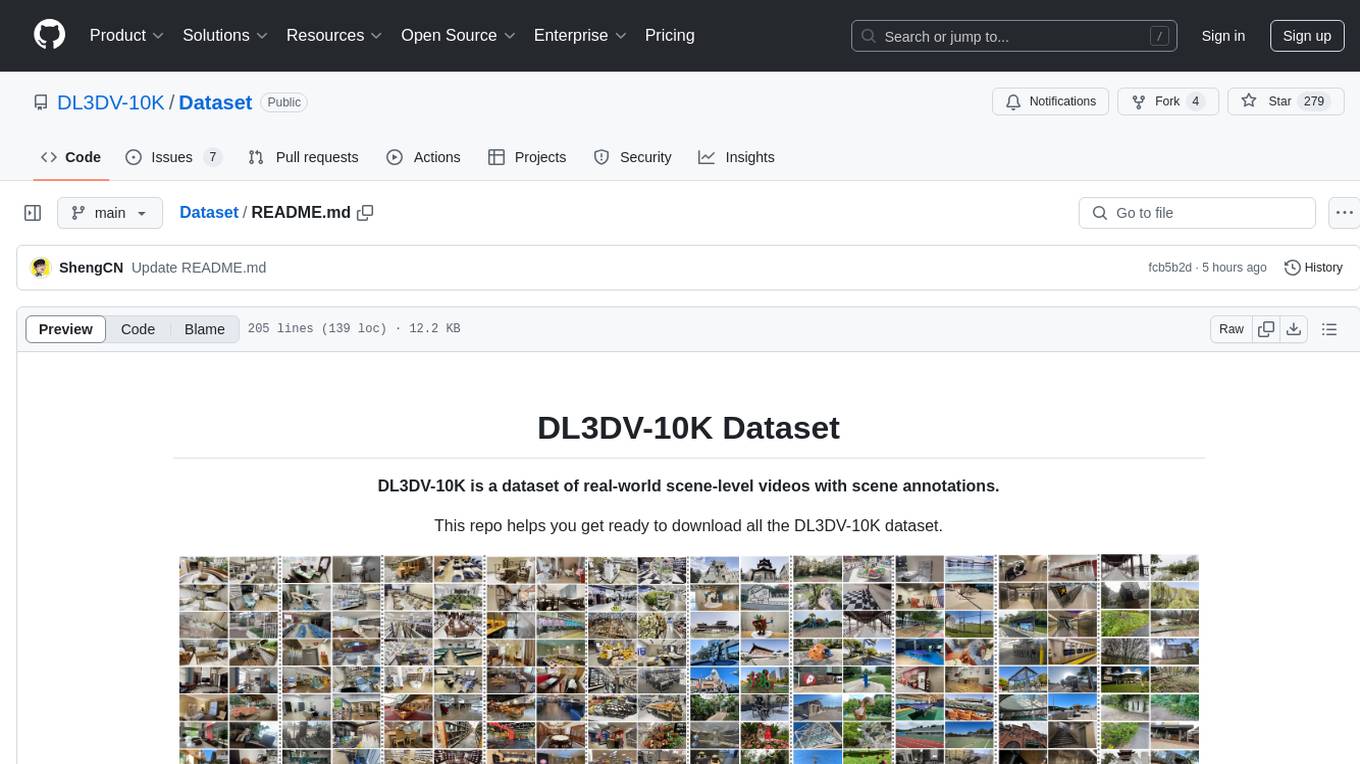
DL3DV-10K is a large-scale dataset of real-world scene-level videos with annotations, covering diverse scenes with different levels of reflection, transparency, and lighting. It includes 10,510 multi-view scenes with 51.2 million frames at 4k resolution, and offers benchmark videos for novel view synthesis (NVS) methods. The dataset is designed to facilitate research in deep learning-based 3D vision and provides valuable insights for future research in NVS and 3D representation learning.
README:
DL3DV-10K is a dataset of real-world scene-level videos with scene annotations.
This repo helps you get ready to download all the DL3DV-10K dataset.

Dataset Download • Website • NVS Benchmark Training Results • Data Preparation • License • Issues • BibTex
We have witnessed significant progress in deep learning-based 3D vision, ranging from neural radiance field (NeRF) based 3D representation learning to applications in novel view synthesis (NVS). However, existing scene-level datasets for deep learning-based 3D vision, limited to either synthetic environments or a narrow selection of real-world scenes, are quite insufficient. This insufficiency not only hinders a comprehensive benchmark of existing methods but also caps what could be explored in deep learning-based 3D analysis. To address this critical gap, we present DL3DV-10K, a large-scale scene dataset, featuring 51.2 million frames from 10,510 videos captured from 65 types of point-of-interest (POI) locations, covering both bounded and unbounded scenes, with different levels of reflection, transparency, and lighting. We conducted a comprehensive benchmark of recent NVS methods on DL3DV-10K, which revealed valuable insights for future research in NVS. In addition, we have obtained encouraging results in a pilot study to learn generalizable NeRF from DL3DV-10K, which manifests the necessity of a large-scale scene-level dataset to forge a path toward a foundation model for learning 3D representation.
- 10,510 multi-view scenes covering 51.2 million frames at 4k resolution.
- 140 videos as Novel view synthesis (NVS) benchmark.
- All videos are annotated by scene environment (indoor vs. outdoor), levels of reflection, transparency, and lighting.
- Released samples include colmap calculated camera pose.
- Benchmark videos offer trained parameters from the SOTA NVS methods, including 3D Gaussian Splatting, ZipNeRF, Mip-NeRF 360, Instant-NGP, and Nerfacto.
We report the performances of the main STOA methods (2023 Fall) on our large-scale NVS benchmark. Here are the quantitative results. Please refer to our paper for more details (e.g. more quantitative and qualitative results.)
Performance on the benchmark. The error metric is calculated from the mean of 140 scenes on a scale factor of 4. Zip-NeRF uses the default batch size (65536) and Zip-NeRF* uses the identical batch size as other methods (4096). Note, the training time and memory usage may be different depending on various configurations.
A presents the density plot of PSNR and SSIM and their relationship on \benchmark~for each method. B describes the performance comparison by scene complexity. The text above the bar plot is the mean value of the methods on the attribute.
DL3DV-10K has more than 10K high-quality videos that cover diverse real-world scenes for 3D vision tasks.
We have formulated the following requirements as guidelines for recording high-quality scene-level videos:
- The scene coverage is in the circle or half-circle with a 30 secs-45 secs walking diameter and has at least five instances with a natural arrangement.
- The default focal length of the camera corresponds to the 0.5x ultra-wide mode for capturing a wide range of background information.
- Each video has a horizontal view of at least 180◦ or 360◦ from different heights, including overhead and waist. It offers high-density views of objects within the coverage area.
- The video resolution should be 4K and have 60 fps (or 30 fps).
- The video's length should be at least 60 secs for mobile phone capture and 45 secs for drone video recording.
- We recommend limiting the duration of moving objects in the video to under 3 secs, with a maximum allowance of 10 secs.
- The frames should not be motion-blurred or overexposed, and the captured objects should be stereoscopic.
We provide a preview page here. The preview page has a snapshot of each scene, its hash code and labels. Some of the missing labels should be updated soon.
-
[x] Free download sample videos (11 scenes)
- [x] Access here
-
[ ] Benchmark dataset release (140 scenes)
- [x] Raw videos
- [x] Benchmark images, camera pose (Ready for download)
- The user requests here.
- We provide both Nerfstudio and 3D Gaussian Splatting formats for benchmark scenes.
- [ ] Benchmark trained weights for 3D Gaussian Splatting, ZipNeRF, Mip-NeRF 360, Instant NGP, and Nerfacto ( Coming soon)
-
[X] 10K Full Dataset Release: The whole dataset is extremly large. Here are different versions for different needs.
- 480P resolution frames with poses (~730G). Dataset link.
- 960P resolution frames with poses (~2.8T).Dataset link.
- 2K resolution frames with poses (~11T). Dataset link.
- 4K resolution frames with poses (~44T). Dataset link.
- 4K videos (~7T). Dataset link.
- COLMAP cache folders (may be useful if you need post-processing based on those cach). Dataset link.
Please go to the relevant huggingface dataset page and request the access. If you request the access, you automatically sign our term of use and license and can access the dataset. Note, the latest license is open to the usage of the dataset. But it is the user's responsibility to keep the use appropriately. The DL3DV organization disclaims any responsibility for the misuse, inappropriate use, or unethical application of the dataset by individuals or entities who download or access it. More details can be found in our license.
If you have enough space, you can use git to download a dataset from huggingface. See this link. 480P/960P versions should satisfies most needs.
If you do not have enough space, we further provide a download script here to download a subset. First make sure you have applied for the access (See above). To set up the environment for the script, call this in your python virtual environment:
pip install huggingface_hub tqdm pandasThe usage for the download.py:
usage: download.py [-h] --odir ODIR --subset {1K,2K,3K,4K,5K,6K,7K,8K,9K,10K} --resolution {4K,2K,960P,480P} --file_type {images+poses,video,colmap_cache} [--hash HASH]
[--clean_cache]
optional arguments:
-h, --help show this help message and exit
--odir ODIR output directory
--subset {1K,2K,3K,4K,5K,6K,7K,8K,9K,10K}
The subset of the benchmark to download
--resolution {4K,2K,960P,480P}
The resolution to donwnload
--file_type {images+poses,video,colmap_cache}
The file type to download
--hash HASH If set subset=hash, this is the hash code of the scene to download
--clean_cache If set, will clean the huggingface cache to save spaceHere are some examples:
# Make sure you have applied for the access.
# Use this to download the download.py script
wget https://raw.githubusercontent.com/DL3DV-10K/Dataset/main/scripts/download.py
# Download 480P resolution images and poses, 0~1K subset, output to DL3DV-10K directory
python download.py --odir DL3DV-10K --subset 1K --resolution 480P --file_type images+poses --clean_cache
# Download 960P resolution images and poses, 0~1K subset, output to DL3DV-10K directory
python download.py --odir DL3DV-10K --subset 1K --resolution 960P --file_type images+poses --clean_cache
# Download 2K resolution images and poses, 0~1K subset, output to DL3DV-10K directory
python download.py --odir DL3DV-10K --subset 1K --resolution 2K --file_type images+poses --clean_cache
# Download 4K resolution images and poses, 0~1K subset, output to DL3DV-10K directory
python download.py --odir DL3DV-10K --subset 1K --resolution 4K --file_type images+poses --clean_cache
# Download 4K resolution videos, 0~1K subset, output to DL3DV-10K directory
python download.py --odir DL3DV-10K --subset 1K --resolution 4K --file_type video --clean_cache
# Download 480P resolution images and poses, 1K~2K subset, output to DL3DV-10K directory
python download.py --odir DL3DV-10K --subset 2K --resolution 480P --file_type images+poses --clean_cacheDL3DV-10K is released under the DL3DV-10K Terms of Use. The DL3DV-10K Terms of Use, disclaimer, and the copy of the license are available in this repository.
Copyright (c) 2024
Despite our best efforts to anonymize data, there may be instances where sensitive details are inadvertently included. If you identify any such issues within the dataset (scenes), don't hesitate to get in touch with us at issue. We will manually redact any sensitive information to ensure the privacy and integrity of the dataset.
Want to contribute the DL3DV-10K dataset? Upload your video here.
The DL3DV-10K team is a non-profit organization with members inlcuding the authors of DL3DV-10K paper and volunteers who contribute to the dataset. Our mission is to make large-scale of deep learning models and datasets available to the general public.
If you found this dataset useful, please cite our paper.
@inproceedings{ling2024dl3dv,
title={Dl3dv-10k: A large-scale scene dataset for deep learning-based 3d vision},
author={Ling, Lu and Sheng, Yichen and Tu, Zhi and Zhao, Wentian and Xin, Cheng and Wan, Kun and Yu, Lantao and Guo, Qianyu and Yu, Zixun and Lu, Yawen and others},
booktitle={Proceedings of the IEEE/CVF Conference on Computer Vision and Pattern Recognition},
pages={22160--22169},
year={2024}
}
For Tasks:
Click tags to check more tools for each tasksFor Jobs:
Alternative AI tools for Dataset
Similar Open Source Tools

Dataset
DL3DV-10K is a large-scale dataset of real-world scene-level videos with annotations, covering diverse scenes with different levels of reflection, transparency, and lighting. It includes 10,510 multi-view scenes with 51.2 million frames at 4k resolution, and offers benchmark videos for novel view synthesis (NVS) methods. The dataset is designed to facilitate research in deep learning-based 3D vision and provides valuable insights for future research in NVS and 3D representation learning.
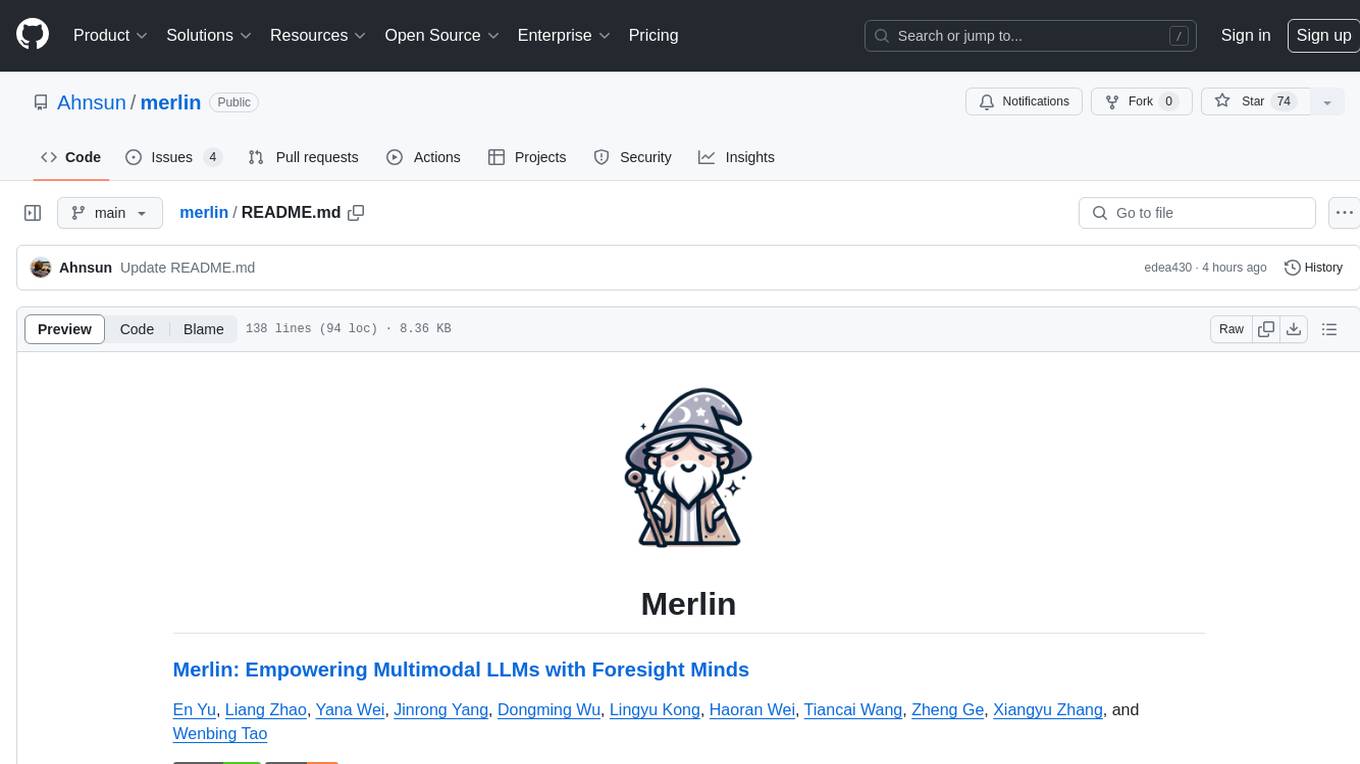
merlin
Merlin is a groundbreaking model capable of generating natural language responses intricately linked with object trajectories of multiple images. It excels in predicting and reasoning about future events based on initial observations, showcasing unprecedented capability in future prediction and reasoning. Merlin achieves state-of-the-art performance on the Future Reasoning Benchmark and multiple existing multimodal language models benchmarks, demonstrating powerful multi-modal general ability and foresight minds.
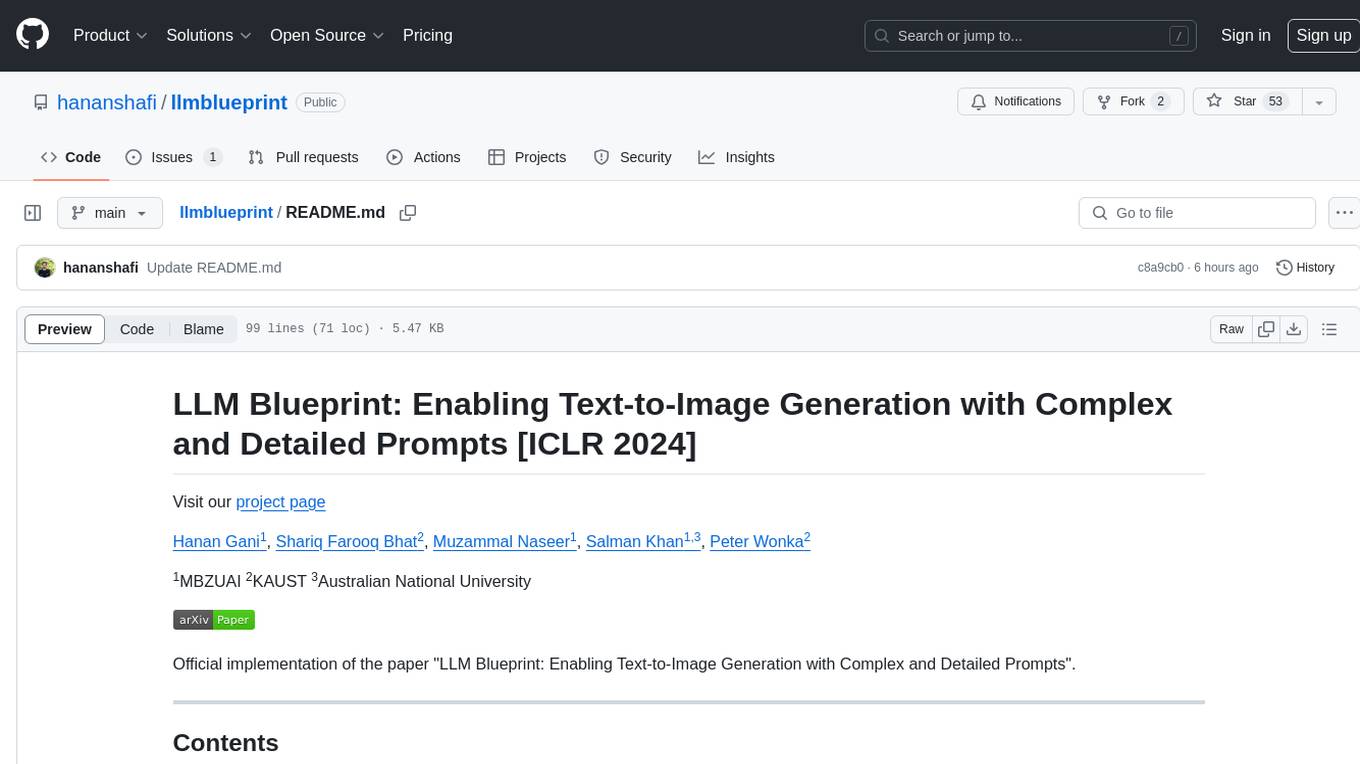
llmblueprint
LLM Blueprint is an official implementation of a paper that enables text-to-image generation with complex and detailed prompts. It leverages Large Language Models (LLMs) to extract critical components from text prompts, including bounding box coordinates for foreground objects, detailed textual descriptions for individual objects, and a succinct background context. The tool operates in two phases: Global Scene Generation creates an initial scene using object layouts and background context, and an Iterative Refinement Scheme refines box-level content to align with textual descriptions, ensuring consistency and improving recall compared to baseline diffusion models.
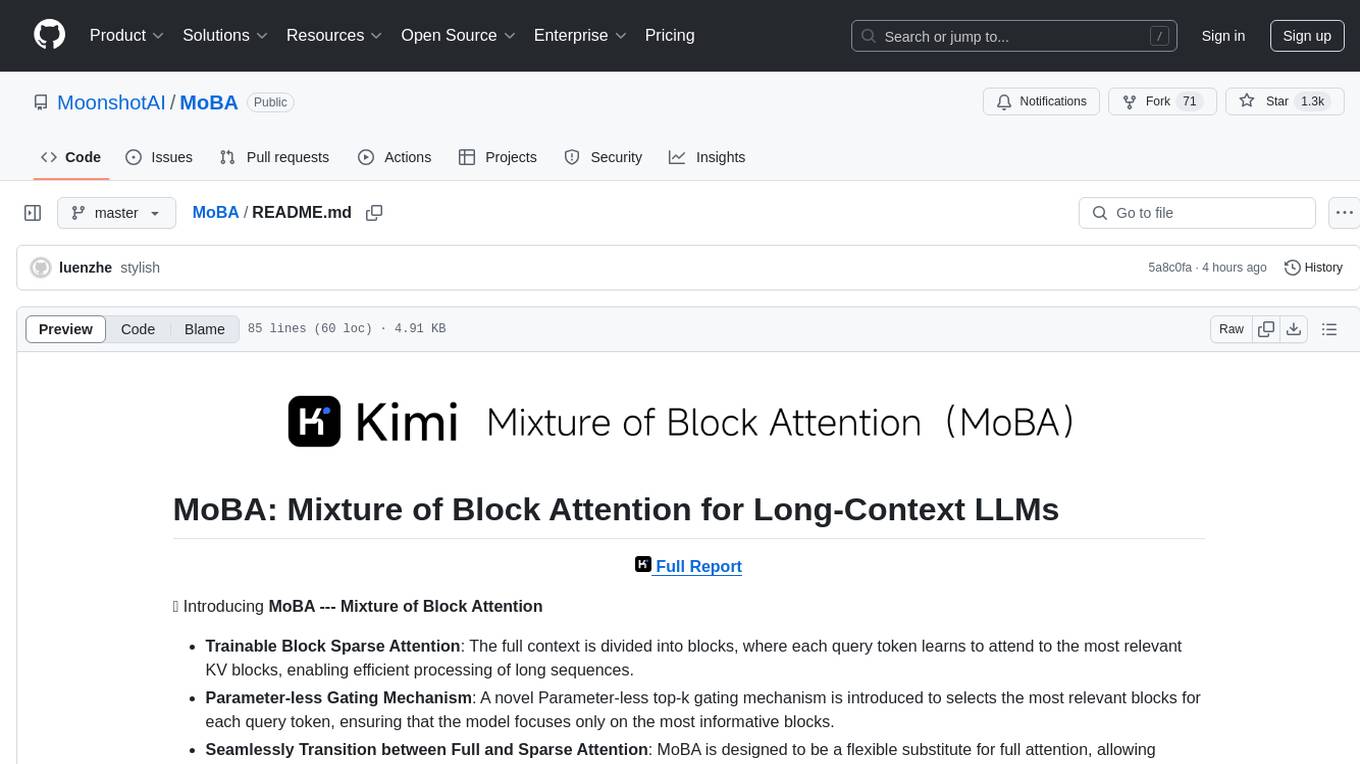
MoBA
MoBA (Mixture of Block Attention) is an innovative approach for long-context language models, enabling efficient processing of long sequences by dividing the full context into blocks and introducing a parameter-less gating mechanism. It allows seamless transitions between full and sparse attention modes, enhancing efficiency without compromising performance. MoBA has been deployed to support long-context requests and demonstrates significant advancements in efficient attention computation for large language models.
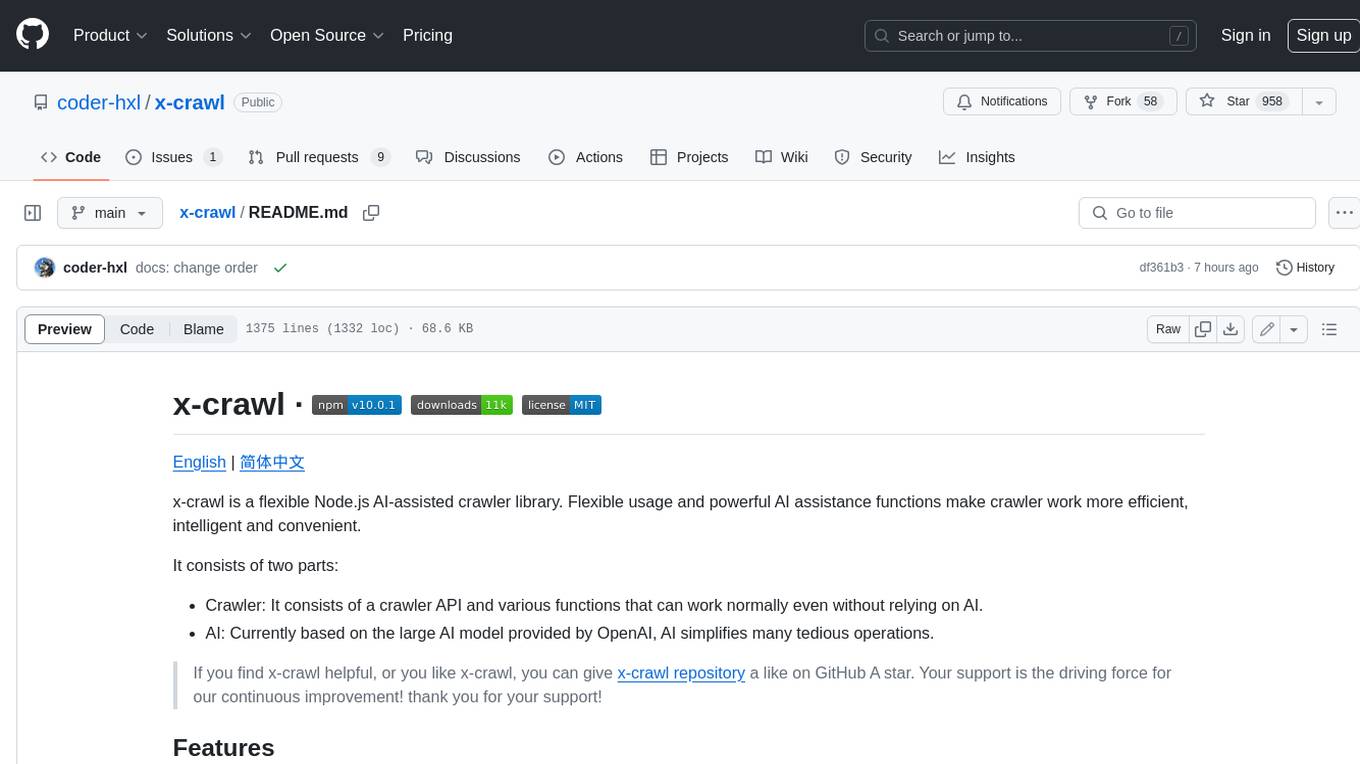
x-crawl
x-crawl is a flexible Node.js AI-assisted crawler library that offers powerful AI assistance functions to make crawler work more efficient, intelligent, and convenient. It consists of a crawler API and various functions that can work normally even without relying on AI. The AI component is currently based on a large AI model provided by OpenAI, simplifying many tedious operations. The library supports crawling dynamic pages, static pages, interface data, and file data, with features like control page operations, device fingerprinting, asynchronous sync, interval crawling, failed retry handling, rotation proxy, priority queue, crawl information control, and TypeScript support.
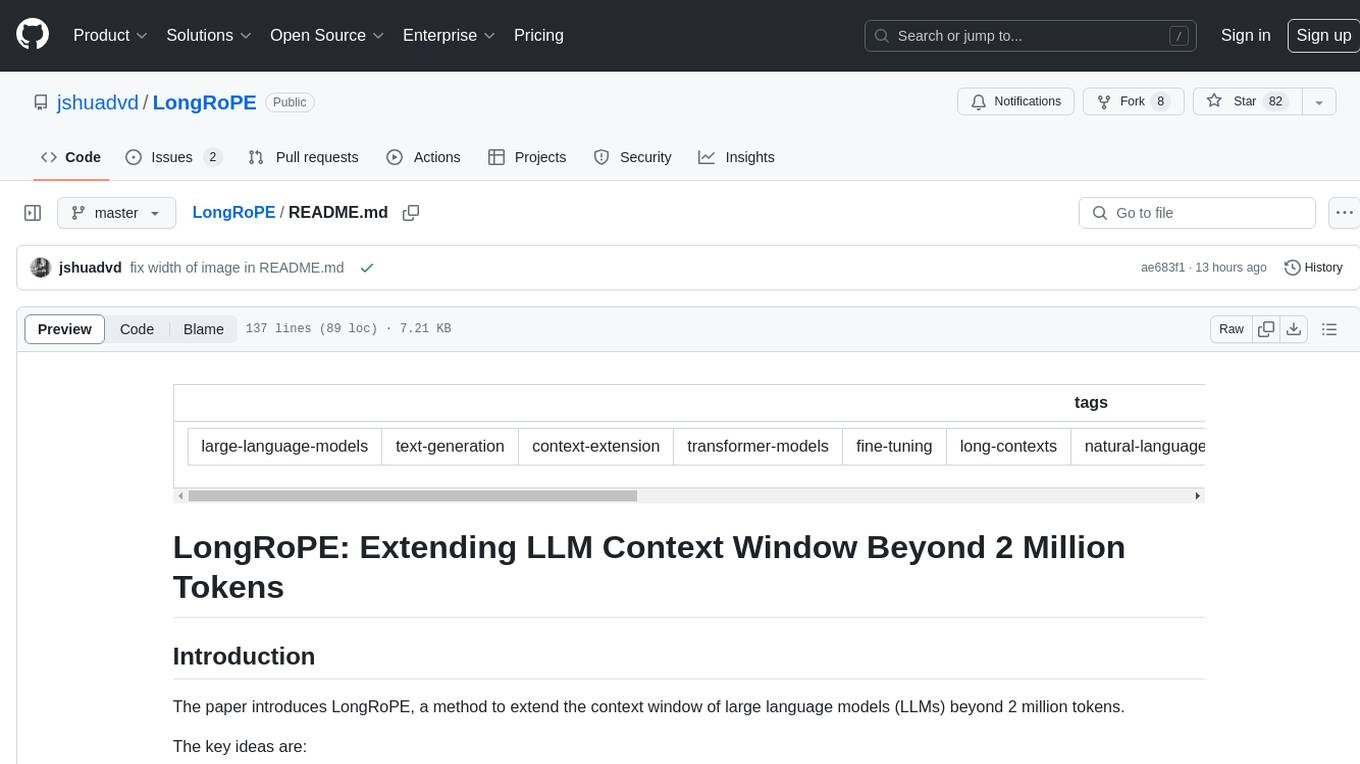
LongRoPE
LongRoPE is a method to extend the context window of large language models (LLMs) beyond 2 million tokens. It identifies and exploits non-uniformities in positional embeddings to enable 8x context extension without fine-tuning. The method utilizes a progressive extension strategy with 256k fine-tuning to reach a 2048k context. It adjusts embeddings for shorter contexts to maintain performance within the original window size. LongRoPE has been shown to be effective in maintaining performance across various tasks from 4k to 2048k context lengths.
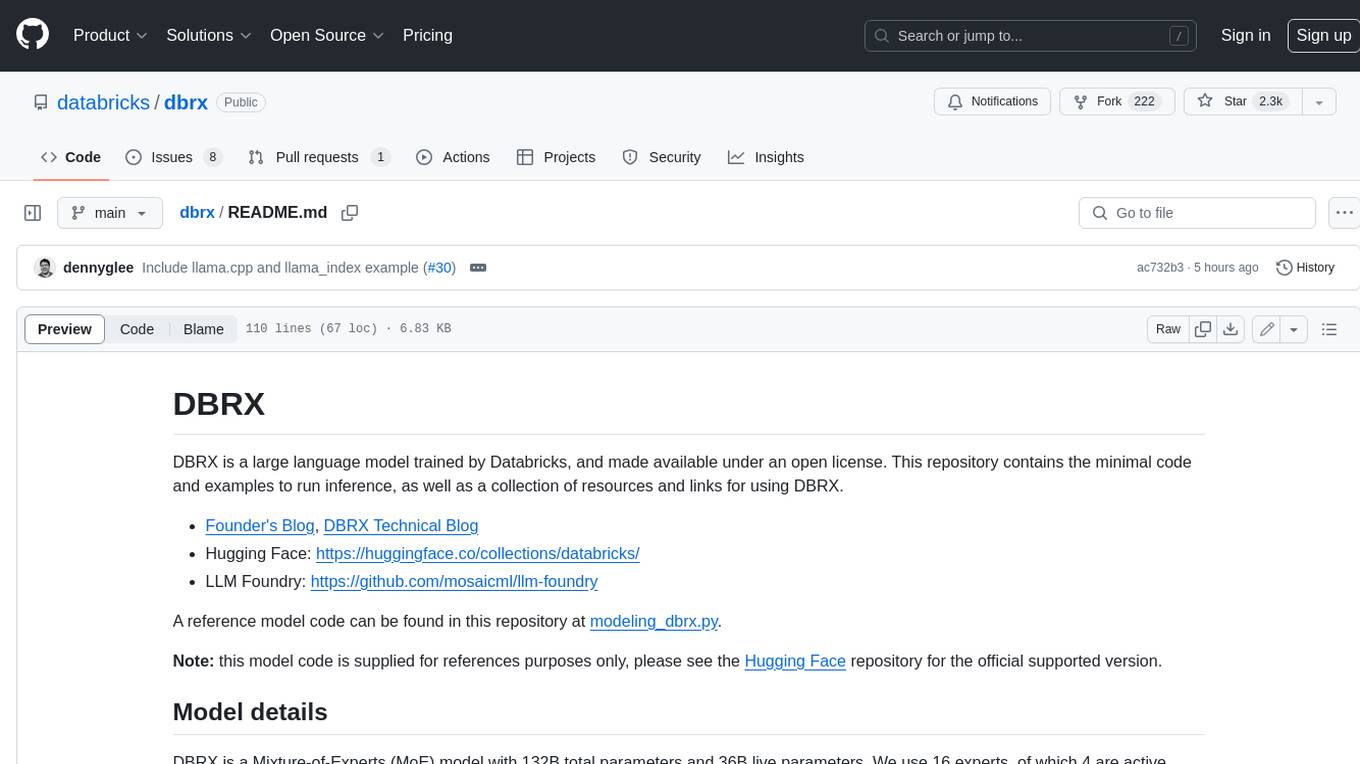
dbrx
DBRX is a large language model trained by Databricks and made available under an open license. It is a Mixture-of-Experts (MoE) model with 132B total parameters and 36B live parameters, using 16 experts, of which 4 are active during training or inference. DBRX was pre-trained for 12T tokens of text and has a context length of 32K tokens. The model is available in two versions: a base model and an Instruct model, which is finetuned for instruction following. DBRX can be used for a variety of tasks, including text generation, question answering, summarization, and translation.
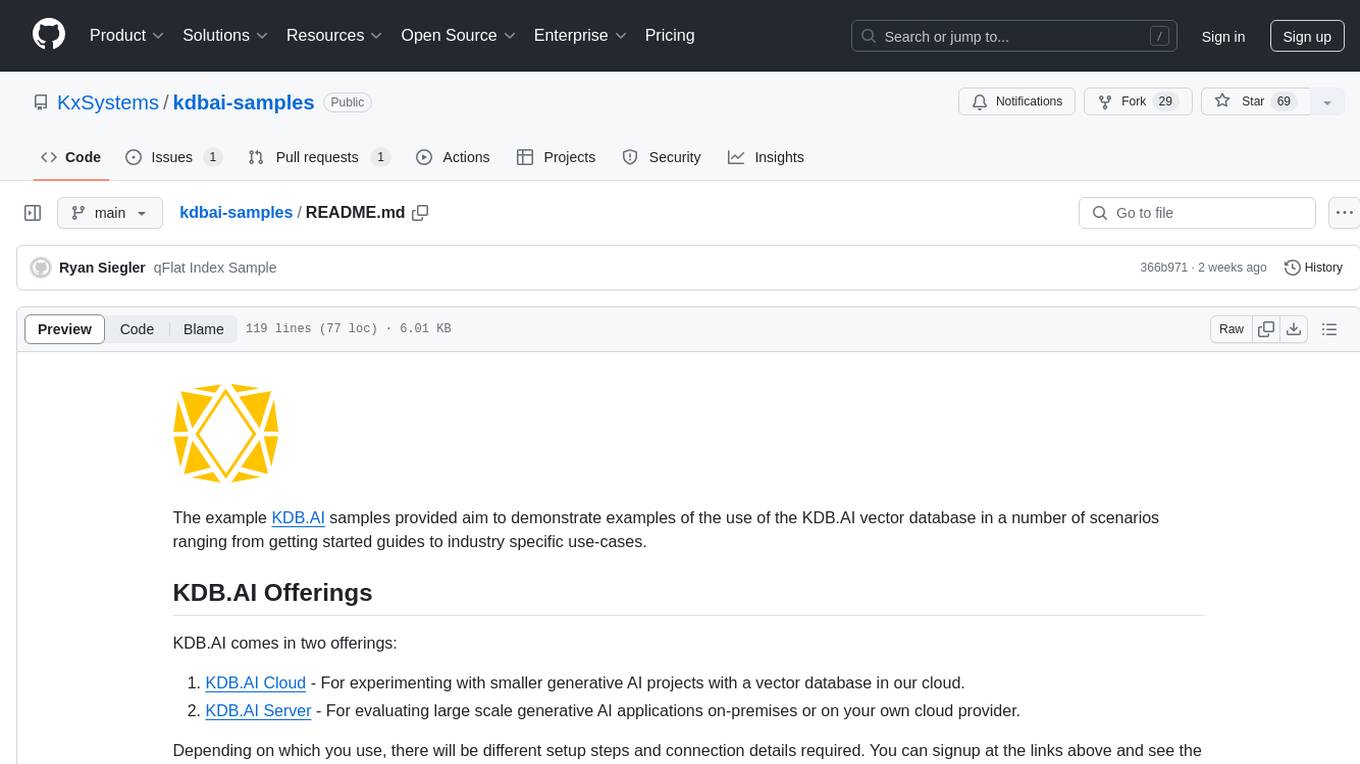
kdbai-samples
KDB.AI is a time-based vector database that allows developers to build scalable, reliable, and real-time applications by providing advanced search, recommendation, and personalization for Generative AI applications. It supports multiple index types, distance metrics, top-N and metadata filtered retrieval, as well as Python and REST interfaces. The repository contains samples demonstrating various use-cases such as temporal similarity search, document search, image search, recommendation systems, sentiment analysis, and more. KDB.AI integrates with platforms like ChatGPT, Langchain, and LlamaIndex. The setup steps require Unix terminal, Python 3.8+, and pip installed. Users can install necessary Python packages and run Jupyter notebooks to interact with the samples.
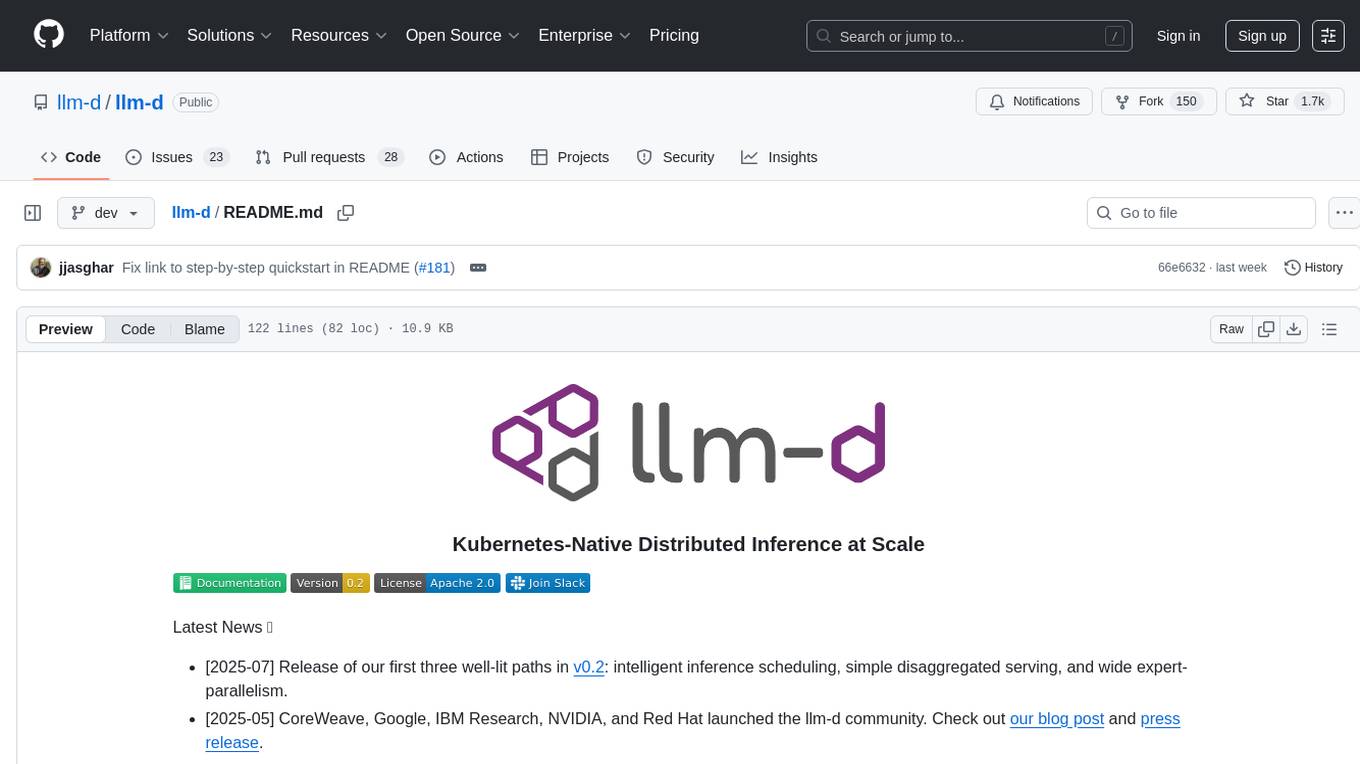
llm-d
LLM-D is a machine learning model for sentiment analysis. It is designed to classify text data into positive, negative, or neutral sentiment categories. The model is trained on a large dataset of labeled text samples and uses natural language processing techniques to analyze and predict sentiment in new text inputs. LLM-D is a powerful tool for businesses and researchers looking to understand customer feedback, social media sentiment, and other text data sources. It can be easily integrated into existing applications or used as a standalone tool for sentiment analysis tasks.
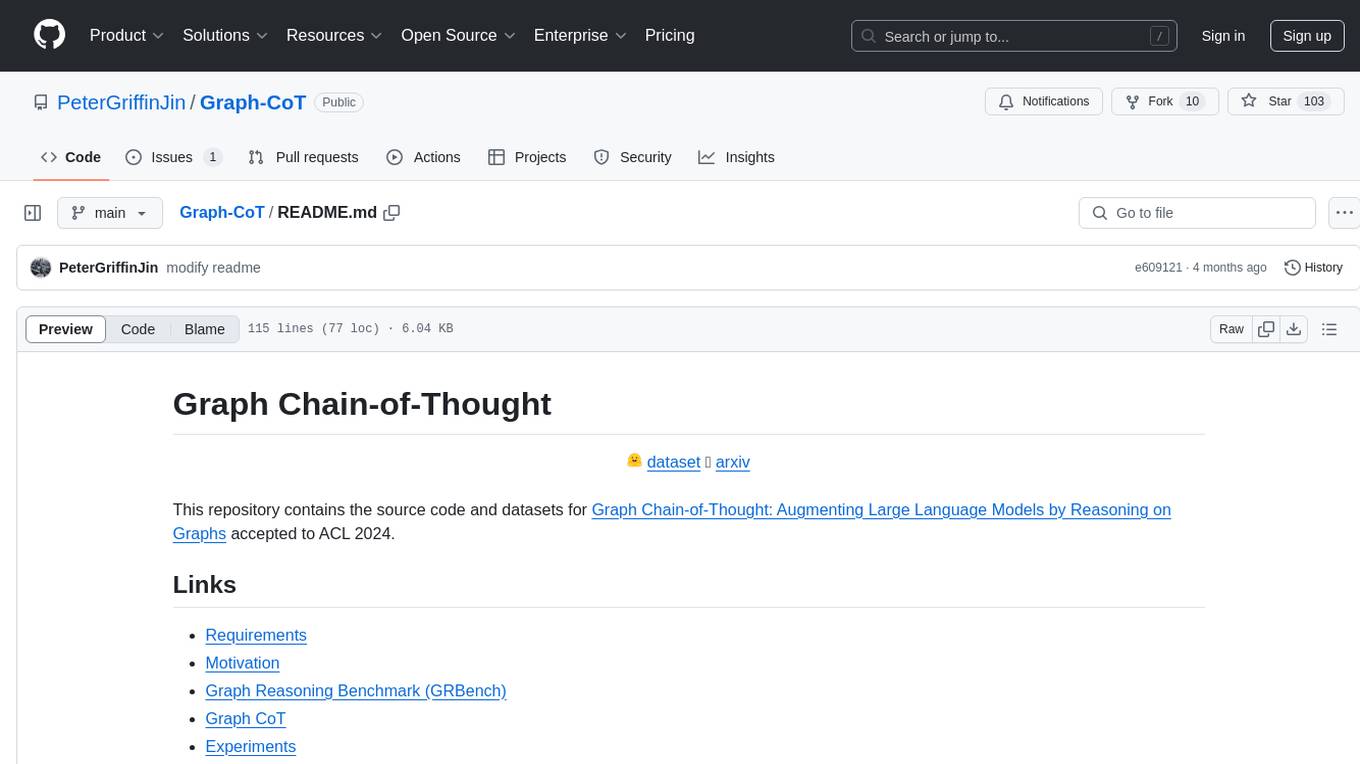
Graph-CoT
This repository contains the source code and datasets for Graph Chain-of-Thought: Augmenting Large Language Models by Reasoning on Graphs accepted to ACL 2024. It proposes a framework called Graph Chain-of-thought (Graph-CoT) to enable Language Models to traverse graphs step-by-step for reasoning, interaction, and execution. The motivation is to alleviate hallucination issues in Language Models by augmenting them with structured knowledge sources represented as graphs.
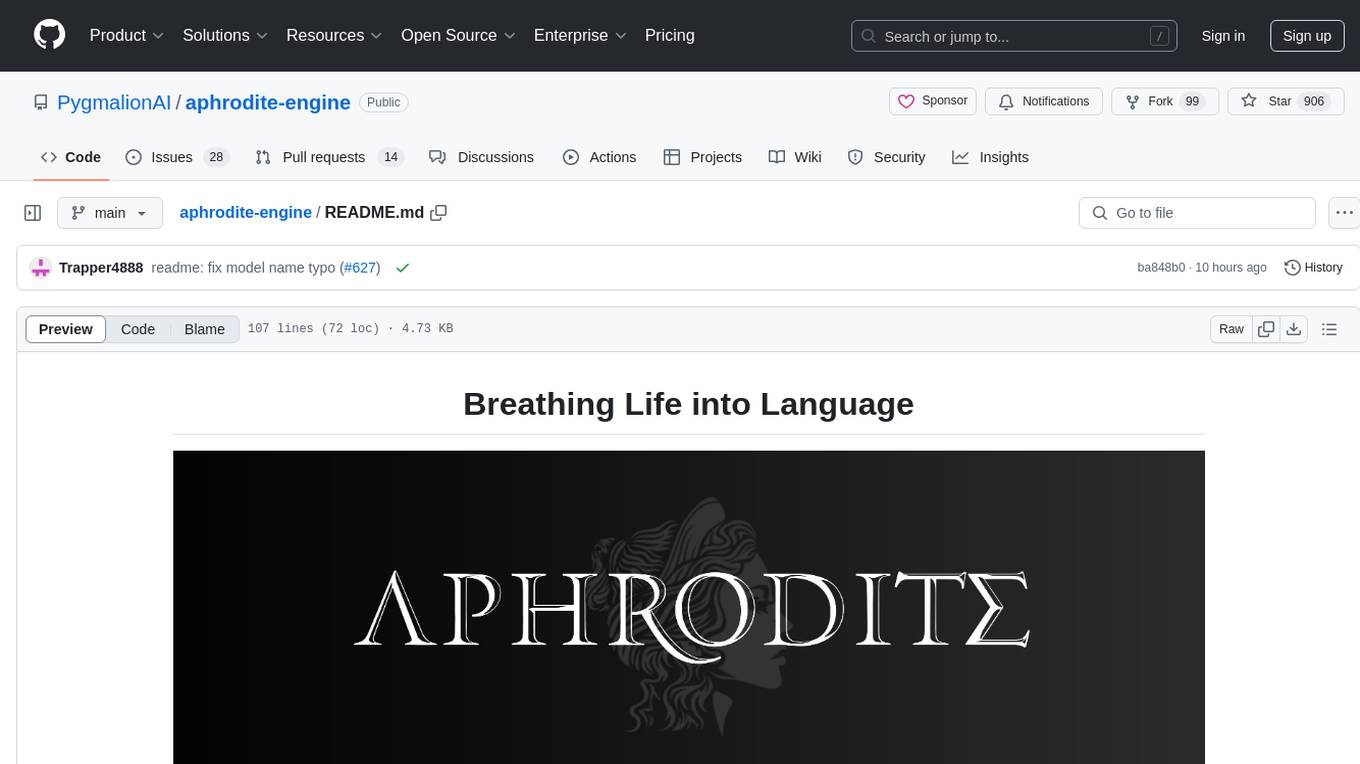
aphrodite-engine
Aphrodite is the official backend engine for PygmalionAI, serving as the inference endpoint for the website. It allows serving Hugging Face-compatible models with fast speeds. Features include continuous batching, efficient K/V management, optimized CUDA kernels, quantization support, distributed inference, and 8-bit KV Cache. The engine requires Linux OS and Python 3.8 to 3.12, with CUDA >= 11 for build requirements. It supports various GPUs, CPUs, TPUs, and Inferentia. Users can limit GPU memory utilization and access full commands via CLI.
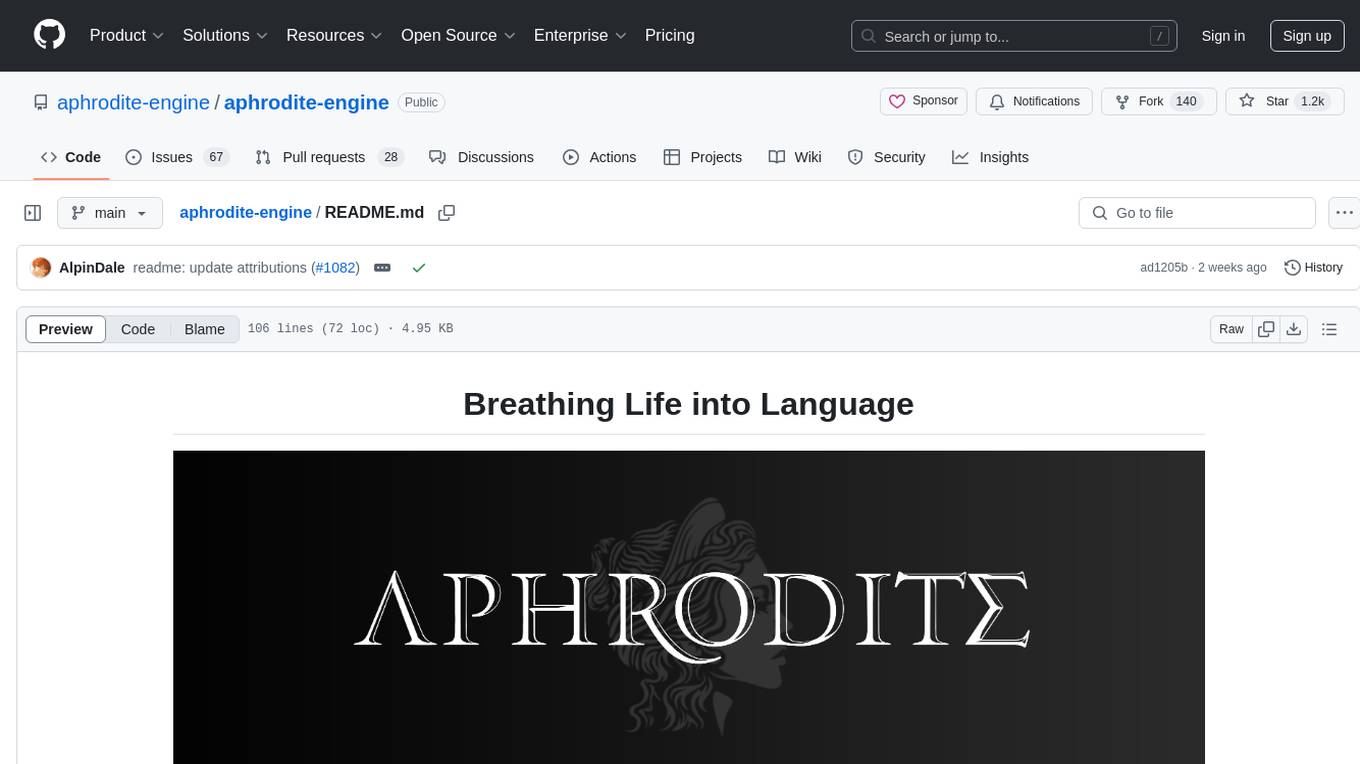
aphrodite-engine
Aphrodite is an inference engine optimized for serving HuggingFace-compatible models at scale. It leverages vLLM's Paged Attention technology to deliver high-performance model inference for multiple concurrent users. The engine supports continuous batching, efficient key/value management, optimized CUDA kernels, quantization support, distributed inference, and modern samplers. It can be easily installed and launched, with Docker support for deployment. Aphrodite requires Linux or Windows OS, Python 3.8 to 3.12, and CUDA >= 11. It is designed to utilize 90% of GPU VRAM but offers options to limit memory usage. Contributors are welcome to enhance the engine.
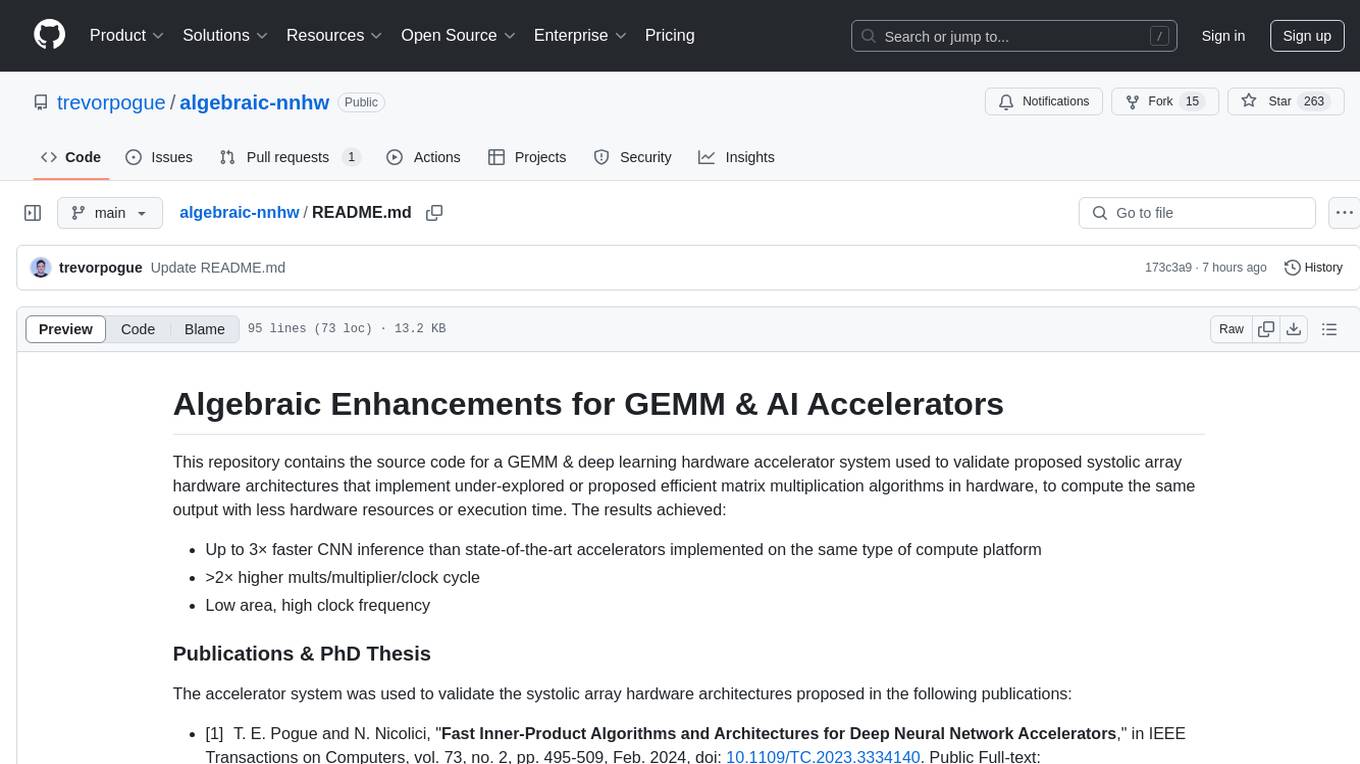
algebraic-nnhw
This repository contains the source code for a GEMM & deep learning hardware accelerator system used to validate proposed systolic array hardware architectures implementing efficient matrix multiplication algorithms to increase performance-per-area limits of GEMM & AI accelerators. Achieved results include up to 3× faster CNN inference, >2× higher mults/multiplier/clock cycle, and low area with high clock frequency. The system is specialized for inference of non-sparse DNN models with fixed-point/quantized inputs, fully accelerating all DNN layers in hardware, and highly optimizing GEMM acceleration.
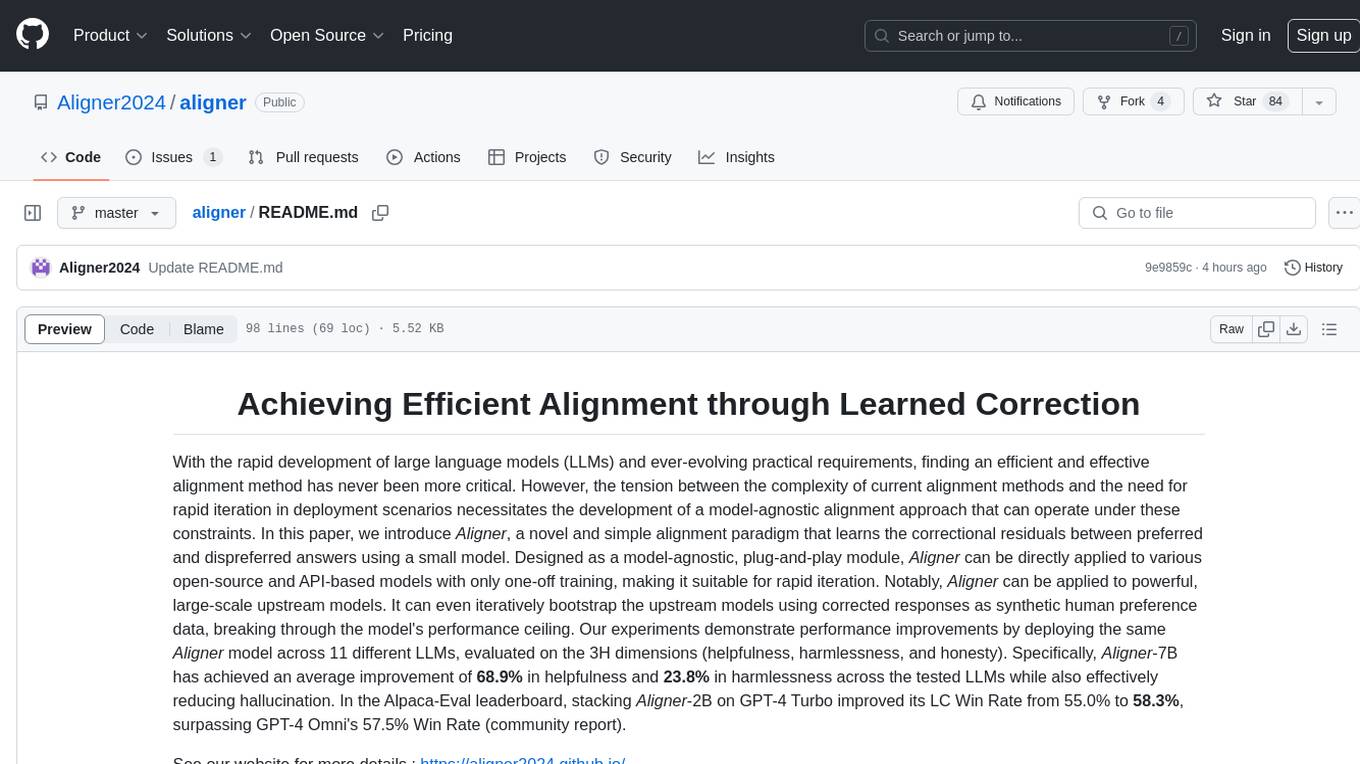
aligner
Aligner is a model-agnostic alignment tool that learns correctional residuals between preferred and dispreferred answers using a small model. It can be directly applied to various open-source and API-based models with only one-off training, suitable for rapid iteration and improving model performance. Aligner has shown significant improvements in helpfulness, harmlessness, and honesty dimensions across different large language models.
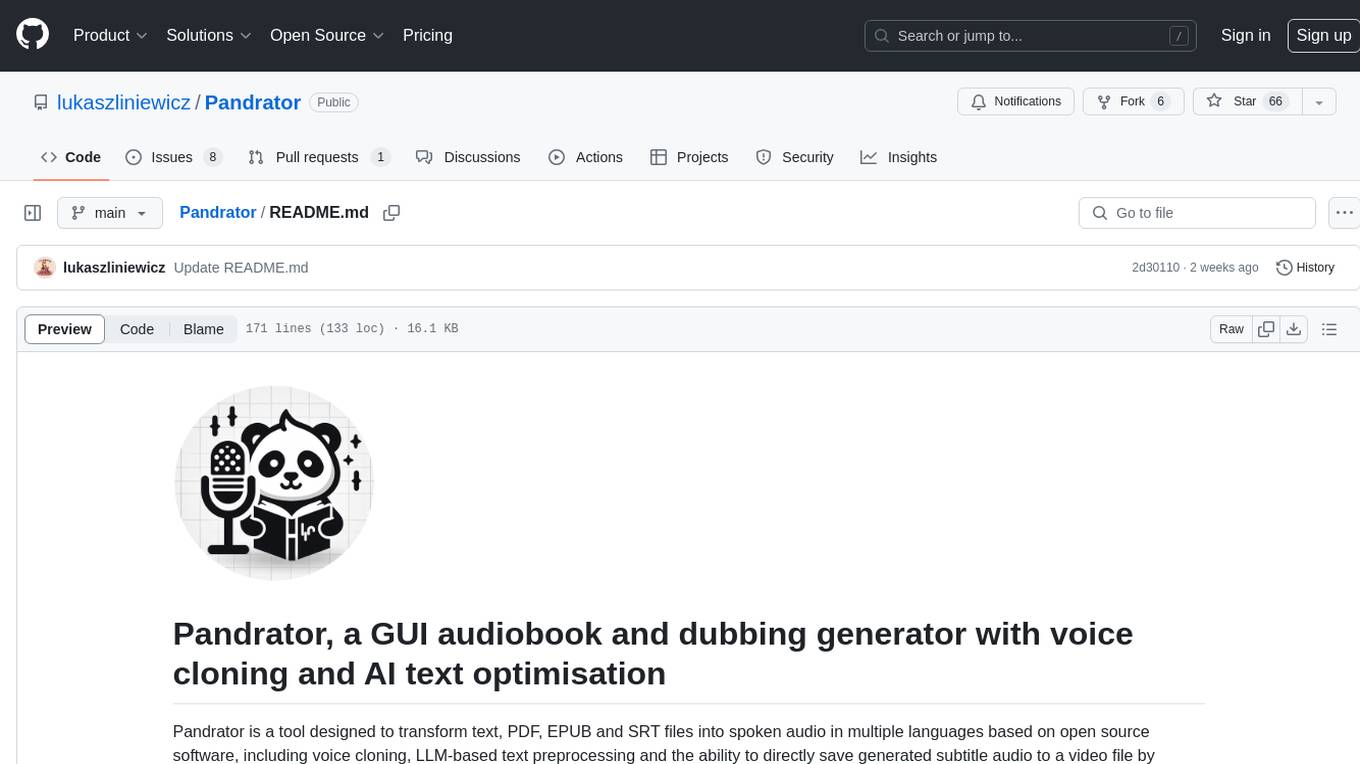
Pandrator
Pandrator is a GUI tool for generating audiobooks and dubbing using voice cloning and AI. It transforms text, PDF, EPUB, and SRT files into spoken audio in multiple languages. It leverages XTTS, Silero, and VoiceCraft models for text-to-speech conversion and voice cloning, with additional features like LLM-based text preprocessing and NISQA for audio quality evaluation. The tool aims to be user-friendly with a one-click installer and a graphical interface.
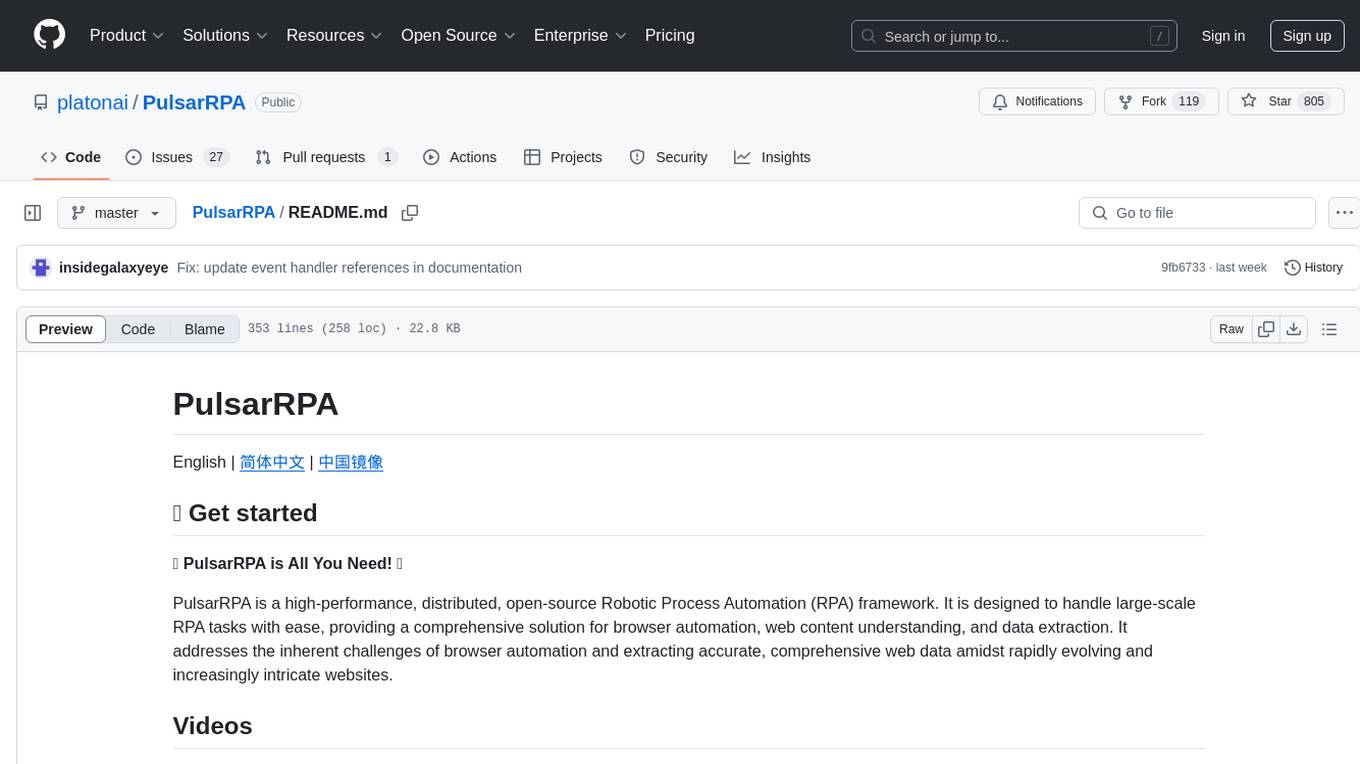
PulsarRPA
PulsarRPA is a high-performance, distributed, open-source Robotic Process Automation (RPA) framework designed to handle large-scale RPA tasks with ease. It provides a comprehensive solution for browser automation, web content understanding, and data extraction. PulsarRPA addresses challenges of browser automation and accurate web data extraction from complex and evolving websites. It incorporates innovative technologies like browser rendering, RPA, intelligent scraping, advanced DOM parsing, and distributed architecture to ensure efficient, accurate, and scalable web data extraction. The tool is open-source, customizable, and supports cutting-edge information extraction technology, making it a preferred solution for large-scale web data extraction.
For similar tasks
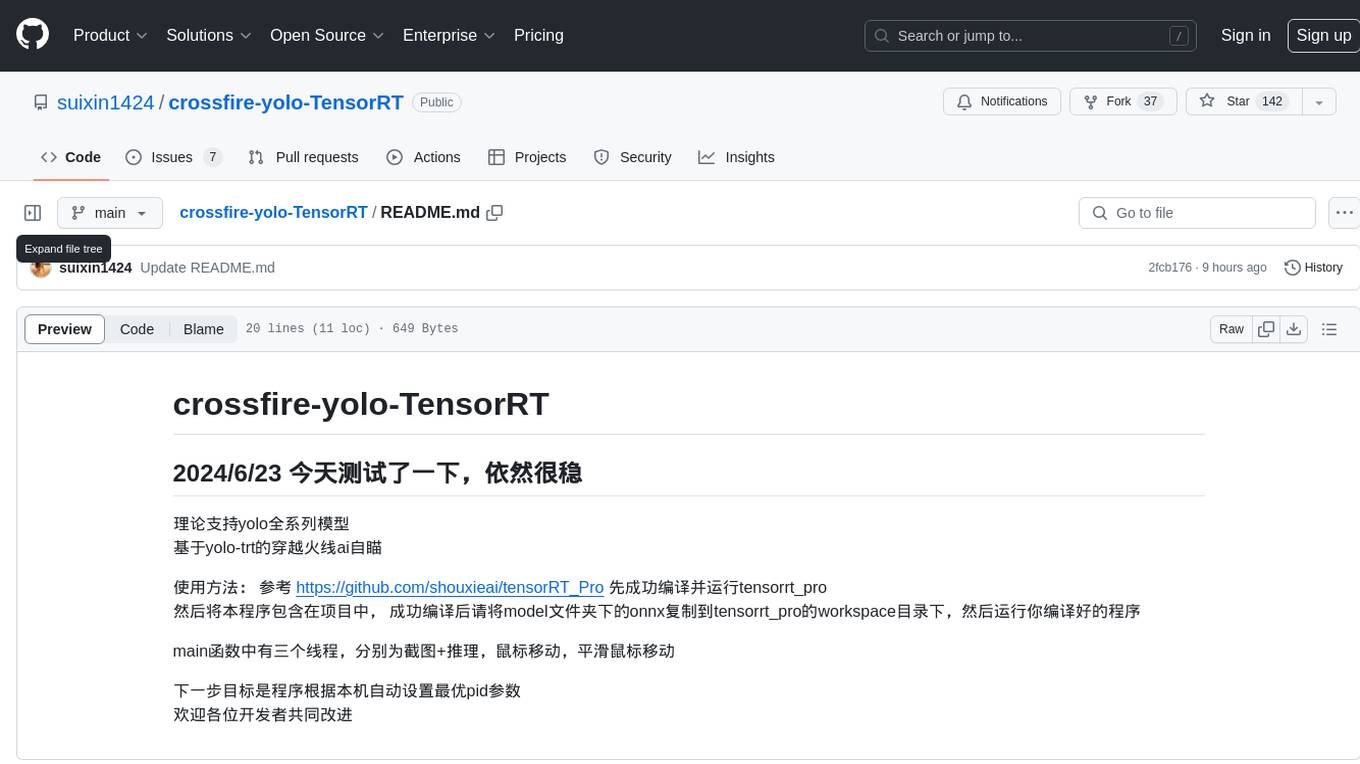
crossfire-yolo-TensorRT
This repository supports the YOLO series models and provides an AI auto-aiming tool based on YOLO-TensorRT for the game CrossFire. Users can refer to the provided link for compilation and running instructions. The tool includes functionalities for screenshot + inference, mouse movement, and smooth mouse movement. The next goal is to automatically set the optimal PID parameters on the local machine. Developers are welcome to contribute to the improvement of this tool.

Dataset
DL3DV-10K is a large-scale dataset of real-world scene-level videos with annotations, covering diverse scenes with different levels of reflection, transparency, and lighting. It includes 10,510 multi-view scenes with 51.2 million frames at 4k resolution, and offers benchmark videos for novel view synthesis (NVS) methods. The dataset is designed to facilitate research in deep learning-based 3D vision and provides valuable insights for future research in NVS and 3D representation learning.
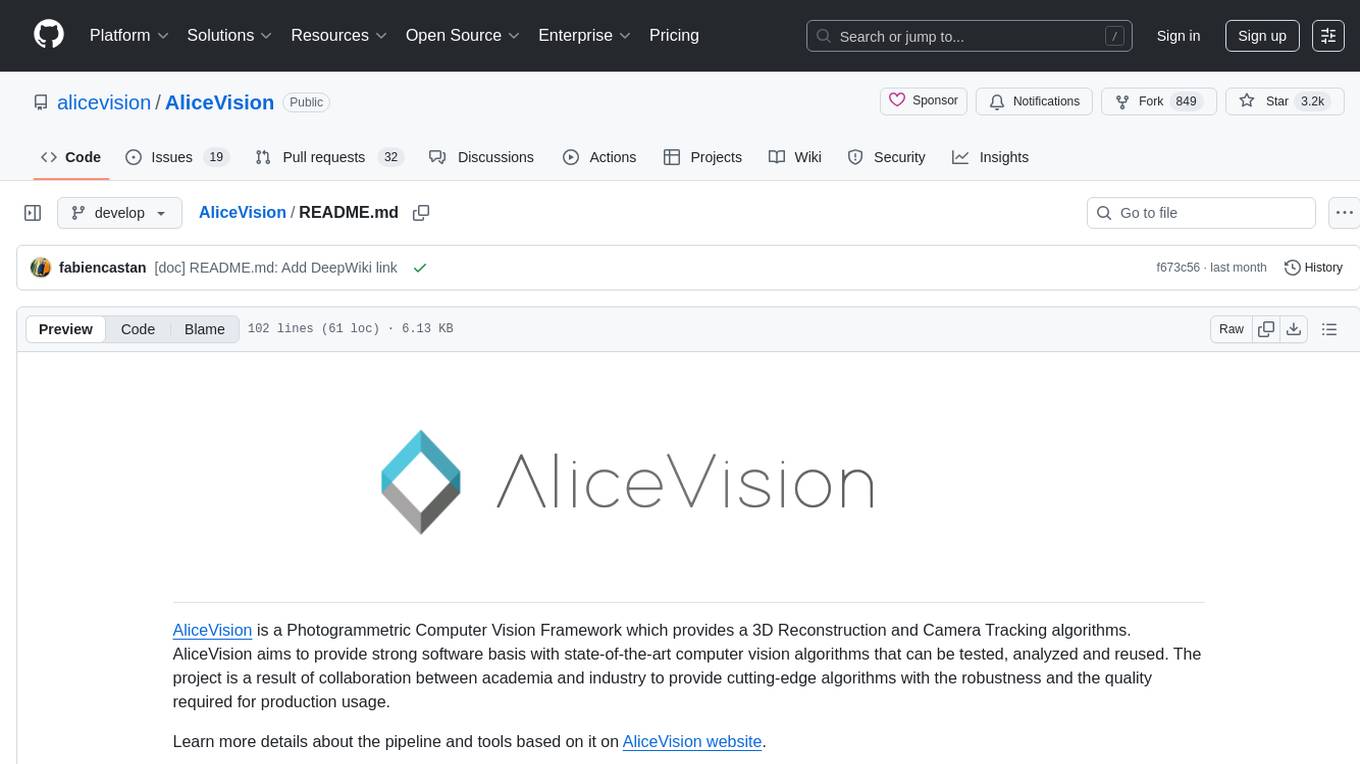
AliceVision
AliceVision is a photogrammetric computer vision framework which provides a 3D reconstruction pipeline. It is designed to process images from different viewpoints and create detailed 3D models of objects or scenes. The framework includes various algorithms for feature detection, matching, and structure from motion. AliceVision is suitable for researchers, developers, and enthusiasts interested in computer vision, photogrammetry, and 3D modeling. It can be used for applications such as creating 3D models of buildings, archaeological sites, or objects for virtual reality and augmented reality experiences.
For similar jobs

weave
Weave is a toolkit for developing Generative AI applications, built by Weights & Biases. With Weave, you can log and debug language model inputs, outputs, and traces; build rigorous, apples-to-apples evaluations for language model use cases; and organize all the information generated across the LLM workflow, from experimentation to evaluations to production. Weave aims to bring rigor, best-practices, and composability to the inherently experimental process of developing Generative AI software, without introducing cognitive overhead.

LLMStack
LLMStack is a no-code platform for building generative AI agents, workflows, and chatbots. It allows users to connect their own data, internal tools, and GPT-powered models without any coding experience. LLMStack can be deployed to the cloud or on-premise and can be accessed via HTTP API or triggered from Slack or Discord.

VisionCraft
The VisionCraft API is a free API for using over 100 different AI models. From images to sound.

kaito
Kaito is an operator that automates the AI/ML inference model deployment in a Kubernetes cluster. It manages large model files using container images, avoids tuning deployment parameters to fit GPU hardware by providing preset configurations, auto-provisions GPU nodes based on model requirements, and hosts large model images in the public Microsoft Container Registry (MCR) if the license allows. Using Kaito, the workflow of onboarding large AI inference models in Kubernetes is largely simplified.

PyRIT
PyRIT is an open access automation framework designed to empower security professionals and ML engineers to red team foundation models and their applications. It automates AI Red Teaming tasks to allow operators to focus on more complicated and time-consuming tasks and can also identify security harms such as misuse (e.g., malware generation, jailbreaking), and privacy harms (e.g., identity theft). The goal is to allow researchers to have a baseline of how well their model and entire inference pipeline is doing against different harm categories and to be able to compare that baseline to future iterations of their model. This allows them to have empirical data on how well their model is doing today, and detect any degradation of performance based on future improvements.

tabby
Tabby is a self-hosted AI coding assistant, offering an open-source and on-premises alternative to GitHub Copilot. It boasts several key features: * Self-contained, with no need for a DBMS or cloud service. * OpenAPI interface, easy to integrate with existing infrastructure (e.g Cloud IDE). * Supports consumer-grade GPUs.

spear
SPEAR (Simulator for Photorealistic Embodied AI Research) is a powerful tool for training embodied agents. It features 300 unique virtual indoor environments with 2,566 unique rooms and 17,234 unique objects that can be manipulated individually. Each environment is designed by a professional artist and features detailed geometry, photorealistic materials, and a unique floor plan and object layout. SPEAR is implemented as Unreal Engine assets and provides an OpenAI Gym interface for interacting with the environments via Python.

Magick
Magick is a groundbreaking visual AIDE (Artificial Intelligence Development Environment) for no-code data pipelines and multimodal agents. Magick can connect to other services and comes with nodes and templates well-suited for intelligent agents, chatbots, complex reasoning systems and realistic characters.



